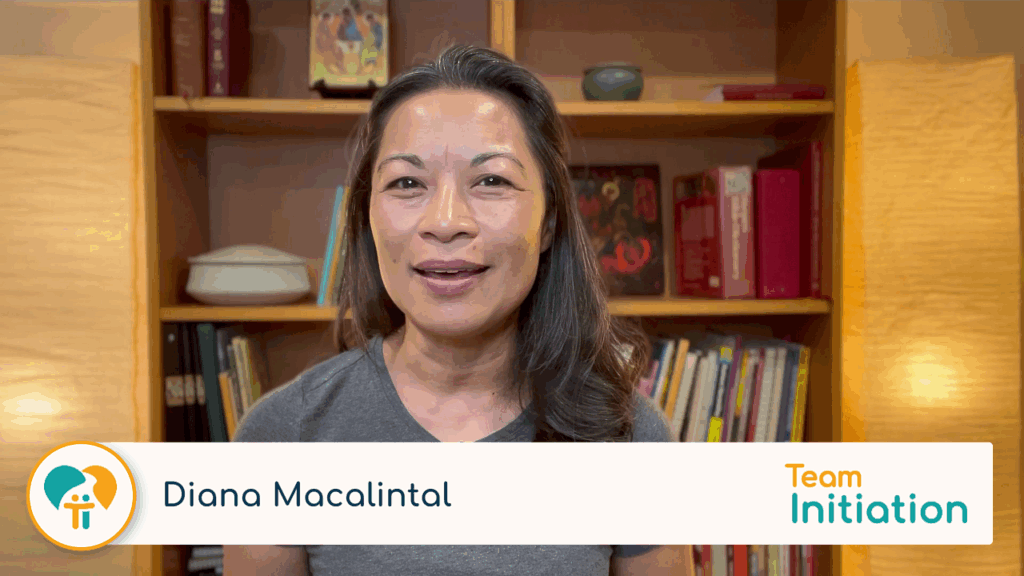
As I’m writing this, we are about two weeks away from the Triduum. And — spoiler alert — Jesus is risen!
It seems like everything has spoiler alerts attached to it these days. The ubiquity of social media has caused many of us to avoid all our screens after the big game that we recorded to watch later or during the premier of the latest superhero movie that we won’t be able to watch for another few days.
We don’t want the surprise to be ruined! And worse, we don’t ever want to be the “spoiler” — the person who ruins the surprise for everyone else.
Except, it seems, when it comes to the elect preparing for initiation. Many of us consider it a pastoral necessity to walk through and explain every moment of the Easter Vigil to those who are about to be baptized. We don’t want them to feel nervous. We don’t want any surprises.
This is not the way the ancient church thought about things, however. Way back in the fourth century, catechumenate leaders practiced a “pedagogy of silence” — allowing the sacred rites and mysteries to teach and reveal themselves, rather than over-explaining everything in advance.
St. Cyril of Jerusalem, for example, believed that experience should precede explanation. St. Ambrose, who was a bishop, catechist, and mentor to St. Augustine, would not talk to the elect before their initiation. It was only after they had experienced the “mysteries” of the sacraments that he felt they could understand what he had to say to them.
St. Augustine did not avoid the elect as strictly as his mentor did, but he did reserve his explanation of the eucharistic celebration until after the neophytes’ first experience of it at the Easter Vigil.
Does that seem strange to you? How could those early leaders — saints of the church! — expect their elect to participate meaningfully without being taught first? What wisdom did they see in the pedagogy of silence that let the ritual speak for itself before elaborating with words?
A pedagogy of silence
If you’re thinking that keeping the elect from knowing the “spoilers” of the Easter Vigil is an outdated idea, then you might have missed what Pope Benedict XVI wrote during his pontificate: “It must first be said that ‘the best catechesis on the Eucharist is the Eucharist itself, celebrated well’” (The Sacrament of Charity, 64).
Just as we don’t expect film critics to spoil the ending before we’ve seen a movie, so too should we allow the sacraments to unveil their meaning as we celebrate them, not by explaining everything in advance. One hallmark of a good film is that it speaks for itself. You don’t need a film critic to tell you what it means before you see it.
Likewise, good liturgy, celebrated well, speaks more eloquently of mystery than will our pre-celebration spoilers. There is nothing we can say ahead of time that will reveal Christ more fully than the symbols and actions of the sacraments. And like a great film’s richness prompting discussion among appreciative viewers, how much more do the sacred mysteries naturally provoke prayerful reflection and sharing of our spiritual experience after we celebrate them?
A pedagogy of silence asks us as ministers to exercise restraint, trusting in the power of symbol, ritual, and mystery to teach without verbal over-direction from us. I’m not suggesting that we be “Ambrosian” and completely avoid the elect until after the Vigil. But maybe we could be a little more “Augustinian,” and prepare the elect spiritually for the commitment they will be making in baptism while at the same time letting the rites speak for themselves through the elect’s own participation in the rites.
If the elect are nervous, reassure them that they won’t be embarrassed, that you and their godparents will guide them every step of the way, that listening and responding to the simple ritual instructions during the rites is all the direction they will need. By allowing the mysteries to unveil themselves in this way, we actually honor the profound respect due to both the elect and the sacraments.
A pedagogy of silence runs counter to many of our modern instincts of systematic preparation. But perhaps we’ve leaned too far in deconstructing mystery through rational analysis, at the cost of losing the sheer wonder and transformative power of encountering the Infinite Other.
Like a great film’s richness prompting discussion amongst appreciative viewers, how much more do the sacred mysteries naturally provoke prayerful reflection and sharing of our spiritual experience after we celebrate them?
Reclaiming a sense of holy wonder
By embracing this ancient pedagogy of silence more intentionally, we can recover a sense of holy wonder — allowing the rites to speak a sacred language beyond words, which forges a more visceral, affective, and mystical connection to the divine realities we’re initiated into.
Our secular age has made us deaf to the symbolic language spoken by ritual, myth, poetry, art, and liturgy. We are so conditioned by our hyper-rational, consumerist culture to demand exhaustive information and total predictability. But human beings aren’t purely rational animals — we’re also mythic, symbolic, imaginative creatures whose deepest selves yearn for more than flat literalism. Pope Francis recently reminded us of this when he quoted philosopher and theologian Romano Guardini: “[We] must become once again capable of symbols” (On the liturgical formation of the People of God, 44).
The mysteries of faith shouldn’t be reduced to textbook formulas or impersonal data downloads, but encountered as primal, embodied experiences that upend our prosaic mindsets. The sacraments aren’t informational inputs, but transformative occasions of grace that lead us into an encounter and relationship with the eternal God.
A pedagogy of silence creates space for holy wonder and sacred surprise — allowing the rites to enlarge our constricted imaginations and rekindle our spiritual senses to realms of meaning beyond rote explanations.
The mysteries of faith shouldn’t be reduced to textbook formulas or impersonal data downloads, but encountered as primal, embodied experiences that upend our prosaic mindsets.
An invitation to mystery
Practically, this doesn’t mean becoming anti-intellectual gnostics withholding truth. Of course there is still a vital place for robust catechesis, theology, and Q&A to unfold the intellectual ramifications of what the sacraments reveal.
But by first letting the mysteries “speak for themselves” through participatory experience, we invite seekers into an expansive space of sacred intimacy — where dogma births sanctity and the heart beholds the rationale for the mind’s affirmations. When we activate this primordial capacity for mythic, symbolic participation, then the fullest meaning of the sacraments is revealed.
So as we enter the Triduum celebrations this year, let’s embrace the venerable wisdom of a “pedagogy of silence.” Let’s not succumb to the modern temptation to constantly explain everything upfront. Rather, let’s have the humble courage to let the mysteries unveil themselves first — awakening a sense of awe, curiosity, and holy wonder within our elect.
In this way, we follow in the footsteps of St. Augustine and the mystagogical tradition at its best. We become midwives ushering people into a living encounter with the inexhaustible dynamism of the sacramental Christ.
Can you help me out?
I’d love to know how this is landing. Can you share a word or a phrase about how this article resonates with you? Does it speak to your experience? Share your thoughts in the comments box below. Thanks for being part of the conversion!


















Wonderful!!! May God Bless you.
Thanks Dcn Gerardo. Have a blessed Holy Week.
This is perfect! Particularly, this year! I have been involved with RCIA for about thirty years and I see the unfolding of faith of our Elect and am excited to see how they will experience this week/ weekend!
Hi Karen. I am excited for our elect also! I think we all are. I don’t know what giving birth is like, but this is as close as I’ll ever get.
Yes…yes and yes! Sacred silence is the domain of wonder, awe, mystery, creativity, the Holy Spirit’s home. Let us respect that home, learn how to be in it and allow the Spirit to be its host. In so doing, we are well on the way to teaching the fundamentals of the spiritual life and of synodality!
Hi Debbie. I was recently told that theologian Howard Thurman would refer to that sacred silence as the “Holy Hush.” Thanks for sharing insight about learning to be in the silence.
I truly appreciate this article about the pedagogy of silence! The Holy Week Liturgies are loaded with deep experiences of Christ’s love! We cradle Catholics sometimes take them for granted! When my husband came into the Church in 1980, he described the surprise (the “unexpected gift”) that he experienced at the Holy Thursday liturgy in the foot washing. He said he hadn’t remembered in the Scriptures that Jesus had washed the Apostles feet at the Last Supper. He was profoundly moved by this beautiful encounter with Christ in this dramatic lesson of His humility and service. It was a beautiful and moving surprise!
Hi Diane. That is a powerful story about your husband’s experience. Thanks for sharing!
This is completely affirming of our Initiation process-thank you! I wholeheartedly agree!
Thanks Mel! Blessings to you and your team.
What does this mean exactly? That we shouldn’t practice with the catechumens ahead of time? That we shouldn’t walk them through the process of the Easter Vigil or show pictures? What are some practical components to “a pedagogy of silence?” Thanks as always for your great insight!
Hi Mandi. That’s correct. I don’t usually walk the elect through the Vigil. Instead, I rehearse their godparents and impress upon the godparents that they need to guide the elect through each step of the Vigil.
I appreciate the affirmation of something I felt strongly about but my collogue did not. It can be difficult to want the candidates to experience the wholeness of their sacraments through all their senses when others are opposed.
Hi Leticia. I’m sorry you are having difficulty. I will keep you in my prayers.